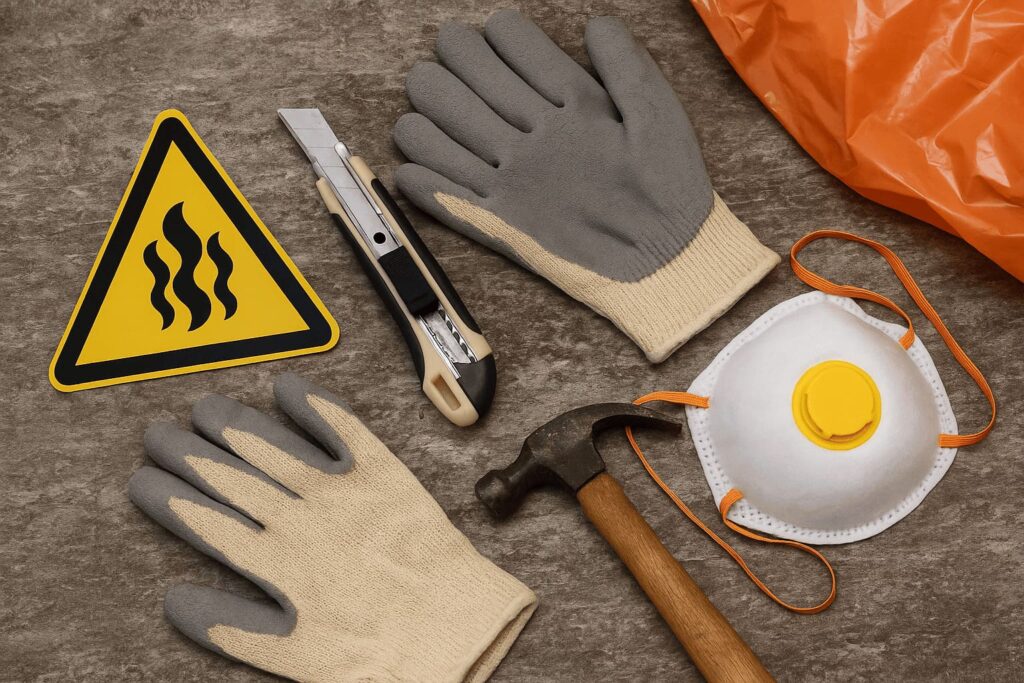Asbestos is a group of mineral fibres once widely used in building materials, insulation, floor tiles, roofing, pipe cement, and more. When intact and undisturbed, many asbestos-containing materials pose a low risk. When damaged, fibres can become airborne and inhaled. Long-term exposure is linked to serious diseases, so even small work involving asbestos must be handled carefully.
National and provincial guidance recommends treating asbestos-containing materials cautiously and following safe removal and disposal procedures. For homeowners in Winnipeg, that means following Manitoba and the City of Winnipeg disposal rules and using licensed contractors for higher-risk work.
First steps if you suspect asbestos
- Don’t panic or disturb the material. The biggest risk comes from disturbing asbestos and releasing fibres. Avoid cutting, sanding, or breaking suspicious materials.
- Get a sample tested by a certified lab. Visual inspection alone can’t confirm asbestos. A small sample should be taken by a trained person or a licensed inspector.
- Assess risk. If the material is intact and won’t be disturbed, many owners choose to leave it in place and manage it. If it will be disturbed during renovation or demolition, plan for proper removal and disposal.
Note: Homeowners should avoid DIY removal for friable asbestos or large jobs. Professional guidance reduces health risks and ensures legal compliance. ccohs.ca
Legal framework for asbestos disposal in Winnipeg
Winnipeg homeowners must follow a mix of federal, provincial, and municipal rules for asbestos handling, removal, transport, and disposal:
- Federal workplace rules (when work involves hired workers) set safe work practices for removal and containment. laws-lois.justice.gc.ca
- Manitoba provincial guidance defines how asbestos waste must be handled and buried at licensed landfills, packaging and transport requirements, and what qualifies as hazardous asbestos. The provincial guideline for asbestos disposal at landfills is a key document for Winnipeg residents. gov.mb.ca
- City of Winnipeg abatement specifications add local requirements for contractors working on municipal projects and provide practical disposal instructions often used by private contractors. City of Winnipeg
Together, these documents require secure containment, clear labelling, trained workers for high-risk work, and delivery to approved disposal facilities. If you are hiring anyone to remove asbestos, confirm they follow these standards and carry appropriate certifications and insurance. gov.mb.ca
When DIY is acceptable and when it is not
May be appropriate for homeowners:
- Very small, non-friable, intact materials that will not release fibres if left alone. In some limited cases, tightly bound non-friable materials can be managed in place.
Do not attempt DIY when:
- The asbestos material is friable (crumbles easily), for example, loose insulation, pipe insulation that will be disturbed, or heavily damaged materials.
- The work will generate dust (cutting, sanding, demolition).
- You lack the right protective equipment, training, and disposal plan.
When in doubt, treat the work as higher risk and hire a licensed asbestos abatement contractor. Health Canada and CCOHS advise homeowners to hire professionals before doing renovations that could disturb asbestos.
Step-by-step: safe removal and disposal process used by professionals
1. Survey and testing
A certified inspector identifies asbestos-containing materials and produces a report that guides the removal plan.
2. Containment and control
Contractors set up containment zones, use negative air units, and follow wet-removal techniques to reduce airborne fibres. HEPA vacuums and disposable drop sheets are standard.
3. Proper packaging and labelling
Asbestos waste is placed into sealed, double-layered bags or leak-proof drums, labelled “asbestos waste,” and left sealed until disposal. Many municipal specs require heavy-duty poly bags and clearly marked containers.
4. Transport to licensed facility
Waste must be transported in enclosed vehicles and delivered to an approved landfill or hazardous waste facility that accepts asbestos. Drivers and carriers may need specific paperwork and training for larger quantities.
5. Final burial or disposal at an approved site
Licensed landfills follow Manitoba guidance for burial and recordkeeping, so asbestos is isolated from public contact. gov.mb.ca
Asbestos types and disposal specifics: asbestos cement pipe disposal and bins
- Asbestos cement (AC) products, such as cement pipe or siding, are non-friable when intact but can release fibres if cut or broken. For disposal, contractors typically avoid breaking these items and package them to prevent fibre release during transport. Local rules require secure packaging and delivery to approved landfills. CAREX Canada
- Asbestos disposal bins: Standard household bins are not suitable for asbestos. Waste must be double-bagged or placed in sealed drums and clearly labelled. If you need containment on site, a licensed contractor or disposal partner can provide approved containers and manage pick-up. Never place asbestos in curbside waste or green bins. City of Winnipeg
Mr. Garbage’s role in asbestos disposal in Winnipeg
Mr. Garbage supports Winnipeg homeowners in two practical ways:
- Disposal partner: For homeowners who have had licensed abatement work completed, Mr. Garbage can receive sealed asbestos waste from certified contractors, ensure it’s transported under local regulations to approved disposal facilities, and manage the paperwork and routing for lawful burial. Our team understands Manitoba landfill acceptance requirements and municipal rules.
- Removal coordinator / trusted referral: For homeowners who need removal, Mr. Garbage can coordinate the project: arrange an initial inspection, put you in touch with licensed asbestos abatement contractors, manage site staging and containment logistics, and then handle lawful disposal once the abatement is completed. This hybrid approach makes the process smoother for homeowners who want a single point of contact.
“Safe asbestos work depends on sound planning and experienced crews. A single coordinator who understands both removal standards and disposal rules makes the job safer and less stressful for homeowners.” — Dr. Emily Clarke, occupational hygienist (industry expert, quoted for context).
Common questions and their answers that homeowners ask
Can I put asbestos in my regular garbage?
No. Asbestos requires special containment, labelling, and delivery to an approved facility. Curbside or regular municipal collection is not appropriate.
Do I need a permit to remove asbestos from my home?
Permitting depends on the scope and whether the work affects workers or public spaces. Licensed contractors will know when permits or notifications are required. Manitoba and the City of Winnipeg’s guidance outline required procedures for larger jobs.
What paperwork should I expect for disposal?
Professional removals usually include waste manifests, labelling, and records of landfill acceptance. For larger volumes, transportation documentation and trained drivers may be required.
How to choose a contractor or disposal partner
- Certification and training: Ask for proof of current licensing, worker training, and insurance.
- References and local experience: Prefer contractors who have completed similar jobs in Winnipeg and know local landfill requirements.
- Clear plan and documentation: The contractor should provide a written asbestos control plan, details about containment, and disposal documentation. City of Winnipeg
- Disposal partner confirmation: If your contractor uses a disposal partner, confirm that the partner accepts asbestos and follows Manitoba landfill guidelines. Mr. Garbage will share disposal details and confirm landfill acceptance for you. Mr. Garbage
Health and safety tips for homeowners during an asbestos project
- Keep family and pets away from the work area.
- Follow the contractor’s instructions on re-entry times after abatement and clearance testing.
- Ask for confirmation that clearance air testing or visual inspection was completed before reoccupying the space.
- Keep documentation and manifests in case future owners or inspectors ask about past asbestos work.
Real-world example (Winnipeg): Problem, Solution, Outcome
A typical Winnipeg renovation story
A homeowner in an older Winnipeg bungalow found suspected asbestos under original vinyl tile during a kitchen renovation. The homeowner stopped work, hired an inspector who confirmed asbestos in the mastic and tiles, then hired a licensed abatement contractor. Mr. Garbage coordinated staging and disposal. The process included containment, HEPA vacuuming, double-bagging waste, and certified transport to a landfill that accepts asbestos under Manitoba guidelines. The homeowner received the disposal manifests and clearance reports and could finish the renovation with confidence.
This example shows the value of pausing work, confirming the hazard with testing, and using a coordinated team that understands both removal and disposal rules.
Where to take asbestos waste in Winnipeg
Manitoba’s guidelines list landfill and transport requirements and indicate that asbestos must be taken to licensed facilities that follow provincial burial protocols. Winnipeg’s municipal documents for asbestos abatement also point to approved handling and disposal practices for contractors. Always confirm with your contractor and disposal partner which facility will accept the waste and that they will provide a record of disposal. gov.mb.ca
Final checklist before you start removal
- Stop and test when asbestos is suspected.
- Hire a licensed abatement contractor for friable or uncertain materials.
- Confirm containment, transport, and landfill acceptance.
- Get manifests and clearance documentation after removal.
Conclusion
Asbestos in the home is a common issue in older Winnipeg houses, but it is manageable when you follow local rules and use experienced teams. Manitoba and the City of Winnipeg guidance require careful containment, trained workers for higher-risk jobs, and delivery to approved landfill facilities. Mr. Garbage can help in two ways: as a disposal partner that accepts and routes sealed asbestos waste to approved facilities, and as a removal coordinator that connects homeowners with certified abatement contractors and manages staging and paperwork. If you suspect asbestos or are planning renovations, take the safe route: stop work, test, and contact a coordination partner who understands local disposal rules.
Ready to talk? Suppose you need help coordinating testing, removal, or lawful disposal in Winnipeg. In that case, Mr. Garbage can connect you with licensed abatement contractors and manage the disposal leg so your project stays safe and compliant. Visit Mr. Garbage‘s website or call us to book an assessment or disposal service.
Frequently Asked Questions (FAQs)
What should I do first if I suspect asbestos in my Winnipeg home?
Stop work and avoid disturbing the material. Arrange for a certified asbestos test; if asbestos is confirmed, consult a licensed abatement contractor before doing any further renovation work.
Can I dispose of asbestos in regular household garbage in Winnipeg?
No. Asbestos must be securely packaged, labelled, and delivered to an approved disposal facility. Regular curbside collection is not permitted for asbestos waste.
What is asbestos cement pipe disposal best practice?
Asbestos cement products should be handled to avoid breaking them, double-bagged or placed in sealed containers, and transported to an approved landfill. Contractors usually avoid cutting the AC pipe on-site to minimize fibre release.
How do I find ‘asbestos disposal near me’ in Winnipeg?
Search for licensed asbestos abatement contractors and disposal partners in Winnipeg. Confirm they use landfills that accept asbestos and provide disposal manifests. Mr. Garbage can coordinate removal and disposal services locally.
What paperwork should I receive after asbestos removal?
You should receive documentation such as an inspection report, an asbestos control plan (for the work), disposal manifests, and clearance or visual inspection results confirming the area is safe to reoccupy.

